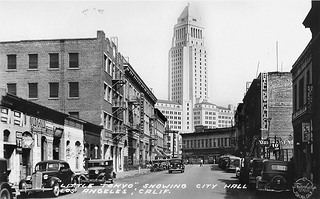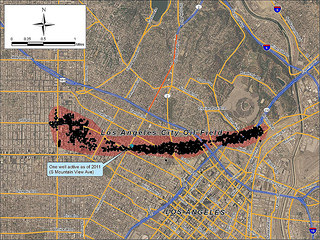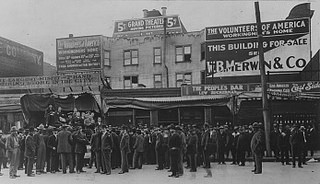Immigration Act of 1924 and Little Tokyo
The Immigration Act of 1924 was a United States federal law that limited the annual number of immigrants who could be admitted from any country to 2% of the number of people from that country who were already living in the United States in 1890. This act halted the steady and significant growth of Little Tokyo in Los Angeles.
Public Transit in the early 1900s
There were several public transportation options for Los Angeles residents, including trolley cars that served many neighborhoods including Little Tokyo. Elevated booths were used by the Los Angeles Railway and the Yellow Cars as a switchman’s tower to control the flow and path of streetcars through the intersection. The image on the left shows the intersection of Main Street, Spring Street, and 9th Street in downtown Los Angeles circa 1917 (2.4 miles from Azusa Street). Note the elevated kiosk at the corner. In 1920, US Census Bureau recorded that Los Angeles had a ...
Decline of Old Chinatown
By the early 1910's the seeds of decline were sown in Old Chinatown, which was located along Alameda Street by Olvera Street, a half mile from Azusa Street. Besides the Exclusion Acts curtailing immigration, the inducements of the new produce center at City Market, co-founded by the Chinese, and a new nearby Chinatown with an evolving residential district led to a gradual population decrease in the Old Place. Symptoms of a generally corrupt Los Angeles, news of wide open gambling houses, vestiges of opium dens, often staged for the unwary tourist, and the fierce tong ...
The Azusa Street Revival
The Azusa Street Revival was a historic Pentecostal revival meeting that took place on Azusa Street in Los Angeles, California and is the origin of the Pentecostal movement. The meetings were led by William J. Seymour, an African American preacher. It began with a meeting on April 9, 1906, and continued seven days a week until roughly 1909. The revival was characterized by ecstatic spiritual experiences accompanied by miracles, dramatic worship services, speaking in tongues, and inter-racial mingling. The participants were criticized by the secular media and Christian ...
Little Tokyo forms
Little Tokyo traces its origins to the first business started by a Japanese seaman named Kame who opened a restaurant on Los Angeles Street, near First Street. The Japanese population grew slowly until the immigrants, known as Issei, decided they want to settle in Los Angeles and raise families. A population surge (over 30,000 Japanese came to America in 1907 alone), fueled by arranged marriages, changed Little Tokyo from a bachelor enclave into a community. Many of the local Japanese were involved in agriculture and that led to the establishment of wholesale produce ...
Downtown Trolleys
The Los Angeles Railway (also Yellow Cars, LARy, latterly Los Angeles Transit Lines) was a system of streetcars that operated in central Los Angeles and the immediate surrounding neighborhoods between 1901 and 1963. The company carried many more passengers than the Pacific Electric Railway's 'Red Cars’, which served a larger area of Los Angeles. The system was purchased by railroad and real estate tycoon Henry E. Huntington in 1898 and started operation in 1901 to serve the 102,479 Los Angeles residents. At its height, the system contained over 20 streetcar lines and ...
Andrew A. Boyle and the development of Boyle Heights
In 1858, Irish-born Andrew A. Boyle (1818–1871) came to Los Angeles from San Francisco (having also previously lived in New Orleans and Texas after his 1832 migration to America. Boyle built the first brick house east of the Los Angeles River, a few blocks from Azusa Street, and cultivated the Lopez vineyards, manufacturing and selling wine under the Paredon Blanco name. He also operated a shoe store in Los Angeles and was a member of the city council.
After Andrew Boyle's death in early 1871, his property passed to his only daughter and her husband, William Henry ...
Death of El Aliso del Viento
After 300 years serving as a spiritual landmark for the region, El Aliso del Viento witnessed the growth of the agricultural industry while proving shade for citrus farmer’s newly constructed home. The next owner created a winery with the surrounding land, but felt El Aliso del Viento was too big and not worth restoring to health as the centerpiece of his winery. El Aliso del Viento was chopped down in 1892, after years of neglect mirroring the changing values and spiritual practices of the people using the land. The new locals did not make a fuss, not many remembered ...
Oil Drilling increases Population in Los Angeles
In 1865, seven years after Edwin Drake developed the first oil drilling system in North America—located in Pennsylvania—Union Matolle Company moved into California’s Central Valley, east of San Francisco. Union Matolle Company hoped to replicate the success of the Pennsylvania drillings and find large amounts of oil in Northern California. During this period, California’s population increased by approximately 375% in the years following the 1849 gold rush, and California’s demand for oil was increasing dramatically. However, Union Matolle failed to find suffici...
Union Rescue Mission and Skid Row
Union Rescue Mission (URM) is one of the largest missions of its kind in America — bringing help and hope to men, women, and children experiencing homelessness in Downtown Los Angeles. URM was founded in 1891 by Lyman Stewart, president and
founder of Union Oil Company. George A. Hilton served as the first superintendent of the Mission, originally known as the Pacific Gospel Union. During those early days, URM took to the streets in gospel wagons to offer food, clothing, and salvation to the less fortunate. Over the years, URM has continued and expanded its efforts ...











